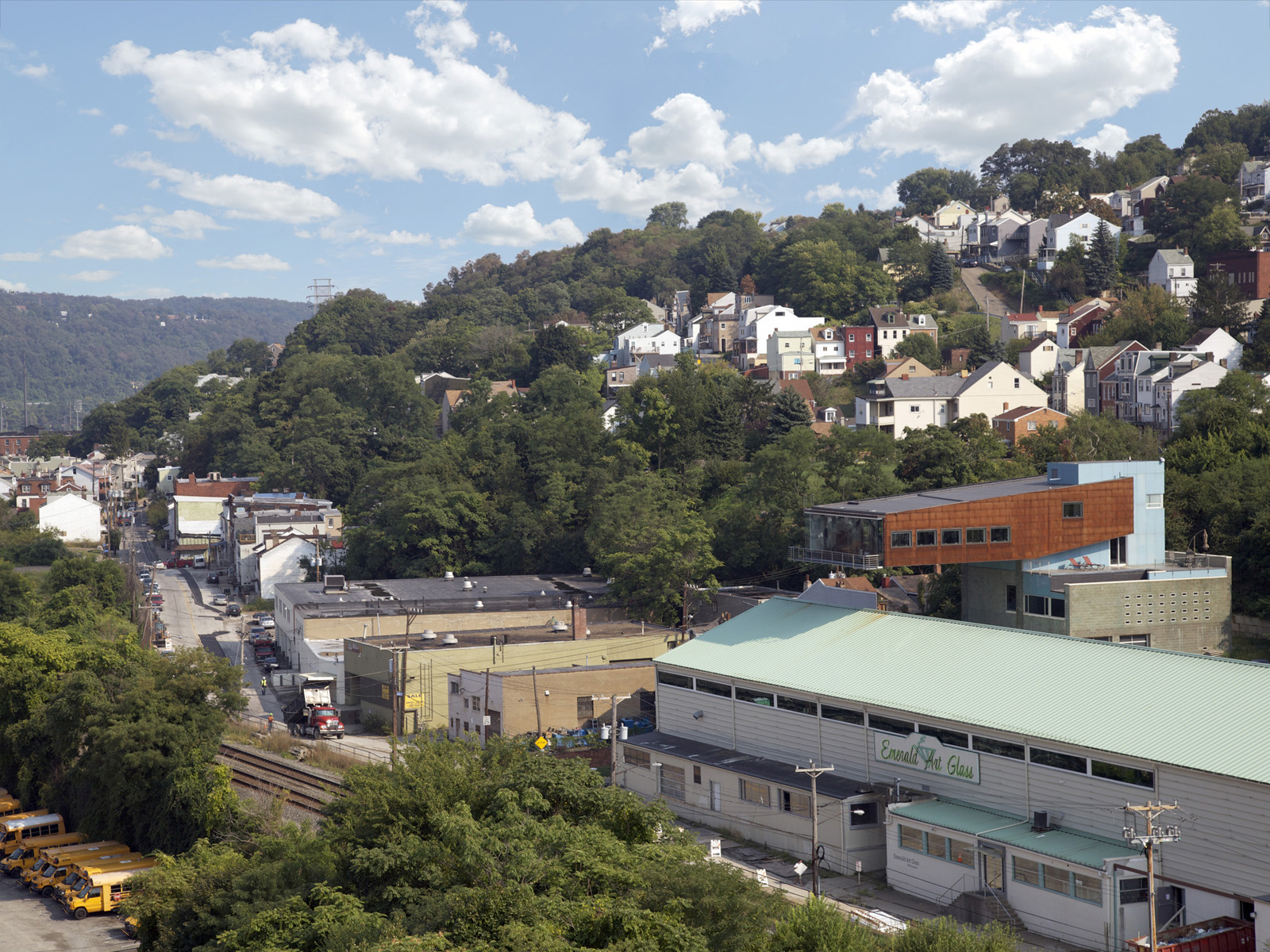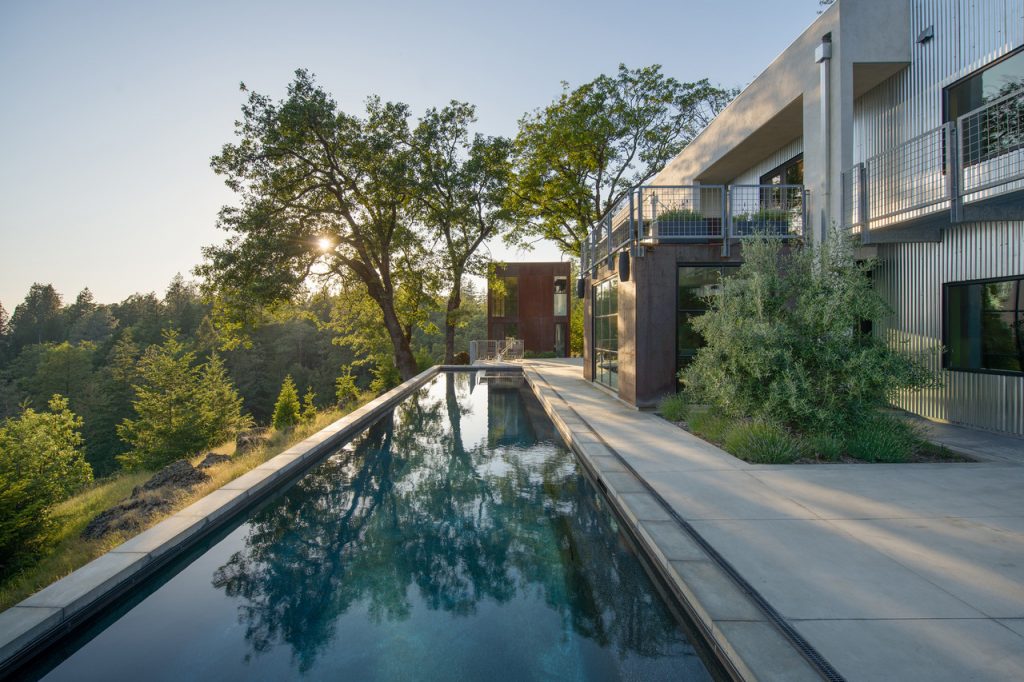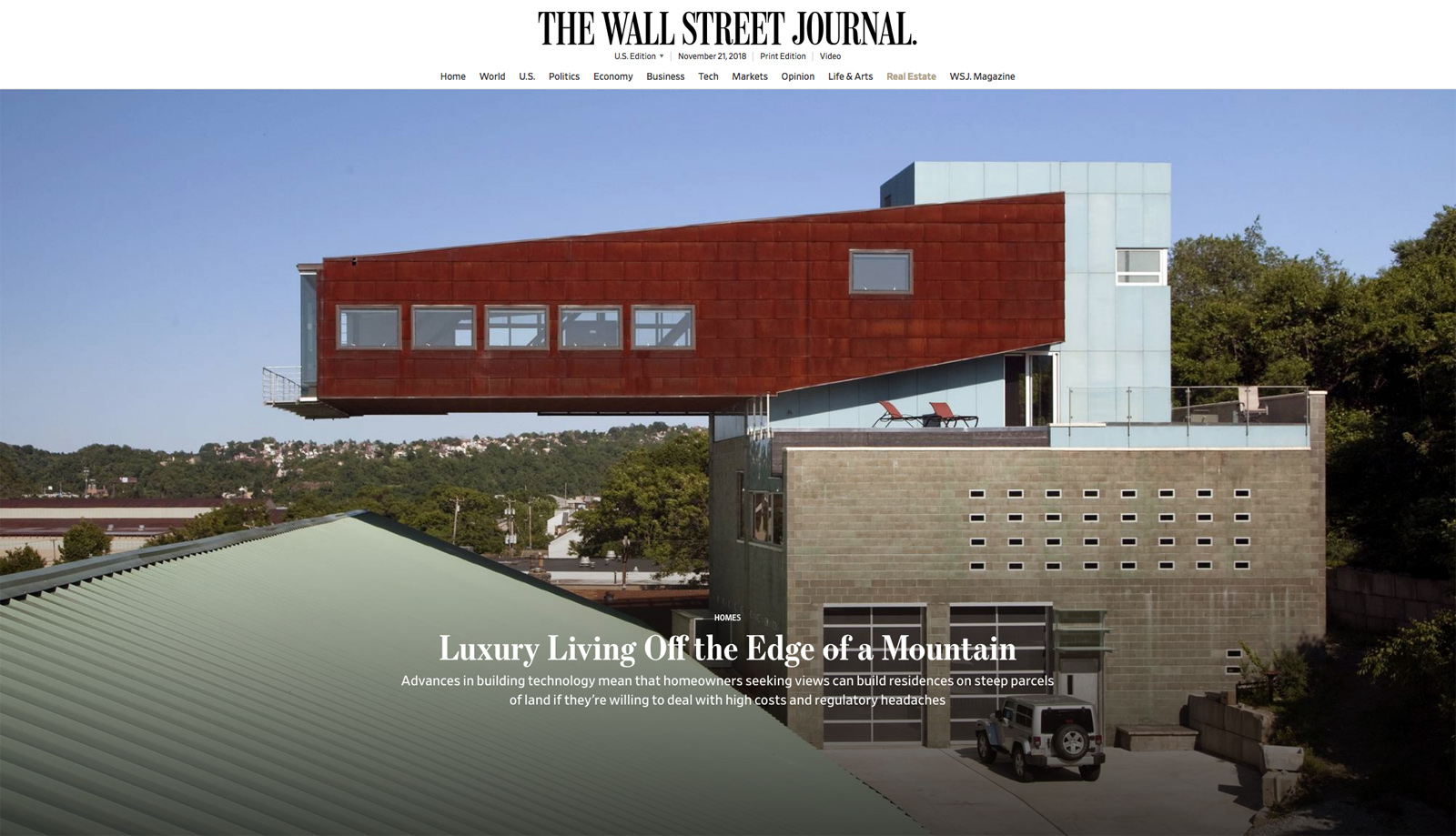[mk_fancy_title strip_tags=”” tag_name=”h3″ style=”” force_font_size=”” line_height=”” letter_spacing=”” margin_top=”” margin_bottom=”” font_family=”Times New Roman, Times, serif” font_type=”safefont”]
When Keith Lesnick and his partner John Killpack were ready to build on a 25-acre parcel they owned in Knights Valley, Calif., they selected a spot boasting tremendous views of mountain peaks and verdant wine country. Their preferred site was also on an average slope of 35%, which caused more regulatory headaches than they could have ever imagined.
Their first site report, provided by the previous owner, didn’t indicate any particularly challenging conditions on the property. They got an engineers’ report, for $8,500, after their architects, Jim Zack and his partner Lise de Vito, of Zack/de Vito Architecture and Construction in San Francisco, had already started some preliminary site design. That report concluded that the soil was unstable. It recommended $500,000 of site work before construction started.
So the couple spent $5,500 for another report, which resulted in a more “builder friendly” opinion. Getting from the first report to the final site remediation plan took four to six months, says Mr. Zack, and involved bringing on a civil engineer and a structural engineer to work out the final site plan. This was all before the couple could move a single speck of dirt for their planned 2,980-square-foot home.
There are reasons homeowners decide to live on the edge. In many communities, precipitously steep parcels boast views and exposure that make them highly coveted. In less exclusive, densely populated regions, the only remaining virgin land is often steeply sloping parcels that were previously thought unbuildable.
High-End Homes Built On the Steeps
These properties in California, Wyoming and Pennsylvania use the latest in engineering and architecture to take advantage of their steeply sloped lots.

Over the last 10 to 20 years, advances in architecture, engineering and construction techniques and technology mean that building on a slope isn’t inherently dangerous, says Thomas Ward, co-founder of Ward+Blake Architects in Jackson, Wyo. “From an engineering perspective,” says Mr. Ward, “other than the cost, there’s no reason you can’t build on a slope considerably more than 30% if you’re willing to deal with the consequences of that.“ (A 30% slope is slightly less steep than a typical black diamond ski run.)
Those consequences, however, are significant. Building a house on a steep slope can add 30% or more to a home building project. Slope issues can also add months, sometimes years, to the design, permitting and approval process.
Before a single line is drawn on an architectural plan, before a single backhoe appears, owners of sloping parcels must often spend thousands on engineering studies to determine whether a site is stable enough to support a foundation—or find out how much it would cost to make it stable.
Around Jackson, these tests are crucial, as a common soil type in the area called loess is “sketchy” at best, Mr. Ward says, and is particularly unstable on steep slopes. Surveys are also important in areas like Seattle, Wash. and Western Pennsylvania, which are known for their extremely steep terrain and a propensity for landslides and sinkholes.

The modernist, 7,000-square-foot, three bedroom home of Kim and Robert Zielinski is built on a precipitous, 50% slope in Pittsburgh’s South Side neighborhood. Designed by Eric Fisher of Fisher ARCHitecture, it cantilevers over the owners’ glass factory, which occupies an adjoining lot below. The home’s foundation is built on 16 concrete piers driven 14 to 28 feet below the surface, and anchored 3 feet into bedrock.
Mr. Zielinski, who specializes in custom glass fabrication, declined to provide the construction costs, but says he never calculated whether the cost of building the home could be recouped at resale. “I don’t even care about selling it,” he says. “That never came into the equation.”
Once a site is determined to be sound geologically and environmentally, design can begin—and that is when local regulations often kick in.
Eric Logan, an architect and principal at Carney Logan Burke Architects in Jackson, says it took six months to navigate the local slope variance process for one of his projects, named Boulder House. He and his staff were required, among many other things, to create a series of documents and exhibits that showed that the chosen design and home location was going to be the least injurious to the site. The owners were required to hold a public hearing on the variance request.
One of Mr. Zack’s current projects, in downtown San Francisco, was subject to the city’s Slope Protection Act (since replaced), which required owners whose property was located within the city’s previous seismic and slope hazard map to commission structural, soil and geological studies. The city had the option to require a peer review of those studies before it would grant building permits—a requirement it made for Mr. Zack’s project. Mr. Zack says this review process added four to five months to the project, which was already an 18-month process to begin with.
Land use experts say each community’s regulations reflect the risks and potential damage that steep slope construction can cause if done improperly. In Telluride, Colo., a key issue is soil stability, and to a lesser extent, rockfall and avalanche. In Lake Tahoe, slope construction causes erosion and runoff that can degrade the lake’s pristine waters. Landslides of developed slopes are a multibillion-dollar problem in Jackson, Seattle and Western Pennsylvania.

Once permitting is done, the really expensive part begins: construction, which isn’t only pricey, but very complicated, according to Bonny and Mark Hershberger, co-owners of landscape architecture and land-planning firm Hershberger Design in Jackson.
Most permitting agencies require preservation of vegetation and minimal disturbance of soil on slopes to prevent erosion, which further restricts where a house can go. Construction materials must often be stored off site. Excavated soil needs to be hauled away instead of redistributed. If the access road is narrow, as it frequently is in mountainous terrain, owners must pay to have construction workers transported into the site because there will be nowhere for them to park, Mr. Hershberger adds.
Unlike on flat terrain, getting a house out of the ground—in other words, doing all the work required to test, permit, design and build a foundation before building the living space even starts—is by far the most expensive part of the slope building process.
Mr. Lesnick says just getting the foundation built for their home was one-third of the total construction cost. Mr. Zack estimates that his current project in San Francisco, sited on a parcel that cost more than $1 million with a slope of around 30%, will cost more than $1.2 million to get out of the ground. He estimates the total cost for the project, which includes two homes, one above the other on the hillside, will be around $1,000 a square foot.
Mr. Logan estimates that construction of the Boulder House foundation cost two to three times what it would have cost to build the same one on flat land. While he declined to specify costs for this project, he said that a home of similar build quality, size and location would cost about $1,500 a square foot to build in 2018.
For owners like Messrs. Lesnick and Killpack, who declined to disclose the total cost to build their Knights Valley home, the hassle and expense was a small price to pay. “Once you wake up in the morning and look at that view, the cost was worth it,” says Mr. Lesnick. Sweeping, enviable vistas gives their living room the appearance of hovering above the valley below, especially on winter mornings when the fog moves in from the ocean.
[/mk_fancy_title]

